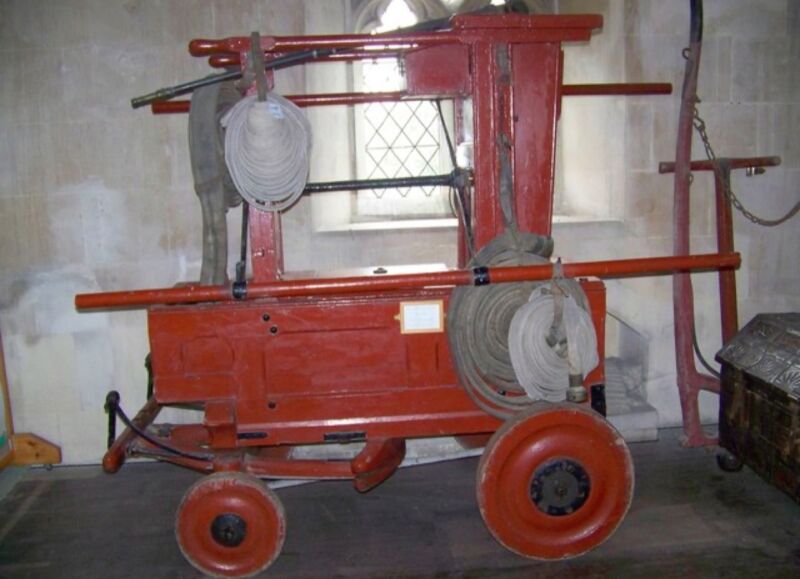
When Don Lemon, a physicist at Bethel College in Kansas, encountered an 18th-century fire engine designed by English Inventor Richard Newsham on display at the Hall of Flame museum in Phoenix, he was intrigued by its pump mechanism. That curiosity inspired him to team up with fellow physicist Trevor Lipscombe of Catholic University of America in Washington, DC, to examine the underlying fluid mechanics and come up with a simple analytical model. Their analysis, described in a new paper published in the American Journal of Physics, yielded insight into Newsham's innovative design, which incorporated a device known as a "windkessel."
A quick Google search on the "windkessel effect" yields an entry on a physiological term to describe heart-aorta blood delivery, dating back to the man who coined it in 1899: German physiologist Otto Frank. "Windkessel" is German for "wind chamber," but the human circulatory system doesn't have a literal wind chamber, so Frank's use was clearly metaphorical. However, there are earlier English uses of the wind chamber terminology that refer to an airtight chamber attached to a piston-driven water pump to smooth the outflow of water in fire engines like those designed by Newsham, per Lemon and Newsham.
Rudimentary firefighting devices have been around since at least 2 BCE, when Ctesibius of Alexandria invented the first fire pump; it was re-invented in 16th-century Europe. Following the 1666 fire that destroyed much of London, there was a pressing need for more efficient firefighting strategies. This eventually led to the invention of so-called "sucking worm engines": leather hoses attached to manually operated pumps. John Lofting is usually credited with inventing, patenting, and marketing these devices, which pulled water from a reservoir while the hose ("worm") enabled users to pump that water in a supposedly continuous stream, the better to combat fires. But nothing is known of his sucking worms after 1696.
In 1721 and 1725, Newsham patented designs for a "water engine for the quenching and extinguishing of fires," with a cistern that could hold as much as 170 gallons of water. Newsham's designs dominated the market for fire engines well into the 1770s, even extending overseas. New York City was using his engines in 1731. And when the Williamsburg Capitol building burned down in 1747, the colony imported one of Newsham's fire engines to better combat future fires; it's still on display in a Colonial Williamsburg museum.
“There are many fascinating physics problems hiding in plain sight within books and papers written centuries ago," said Lipscombe. “Recently we’ve been working on applying elementary fluid mechanics to biological systems, and came across a common description in medical journals: that the heart acts as a windkessel. That begs the question of what, precisely, is a windkessel? Following the trail, we found descriptions of Lofting’s ‘sucking worm’ device and, in Newsham’s fire engine, a lifesaving application.”

To find out more, they collected data from early documents (patents, advertisements, photographs, and so forth) and current videos of the fire engines in operation and were able to personally inspect one surviving windkessel at the Phoenix Hall of Flame. For instance, the marketing materials for Lofting's sucking worm claimed it was able to pump "a continuous stream" of water "400 feet high."
The authors believe both of these claims are likely exaggerations, based on their examination of the fluid mechanics. While a manually operated pump could produce a stream with the required ground level speed of 22 meters/second, "without the addition of some device to regulate and smooth the stream of water, a piston-driven pump would produce water in spurts, rather than, as advertised, continuously," they wrote. "But no such regulating device is mentioned in Lofting's sucking-worm patent of 1690 or illustrated in his advertisements."
There is mention of such a regulating device to produce a continuous stream of water in a 1690 Dutch treatise by Jan van der Heyden, but van der Heyden never provided any specifics of the "internal parts," per Lemon and Lipscombe, perhaps to avoid patent infringement. Fortunately, there are several surviving Newsham fire engines that incorporate a stream-regulating device. (It's unclear who invented the regulating device, but apparently it wasn't Newsham or Lofting.) Two men usually pulled the fire engine to the scene of a fire, while a bucket brigade kept its coffin-shaped open container filled with water.
Manually operated pistons pulled the water from the reservoir and pumped it through the windkessel. Pumped water would enter the windkessel initially at a high-injection rate, trapping and compressing the air in the upper part of the chamber. When the injection rate decreased, the compressed air expanded and expelled water through a metal pipe or hose toward the fire. The two pumps each had leather flaps so that one could draw water up from the reservoir while the other pumped water into the windkessel, producing a mostly continuous stream except when the pistons reversed their directions. "Even so, the output of a two-piston pump varies with time," the authors wrote.


3175x175(CURRENT).thumb.jpg.b05acc060982b36f5891ba728e6d953c.jpg)

Recommended Comments
There are no comments to display.
Join the conversation
You can post now and register later. If you have an account, sign in now to post with your account.
Note: Your post will require moderator approval before it will be visible.